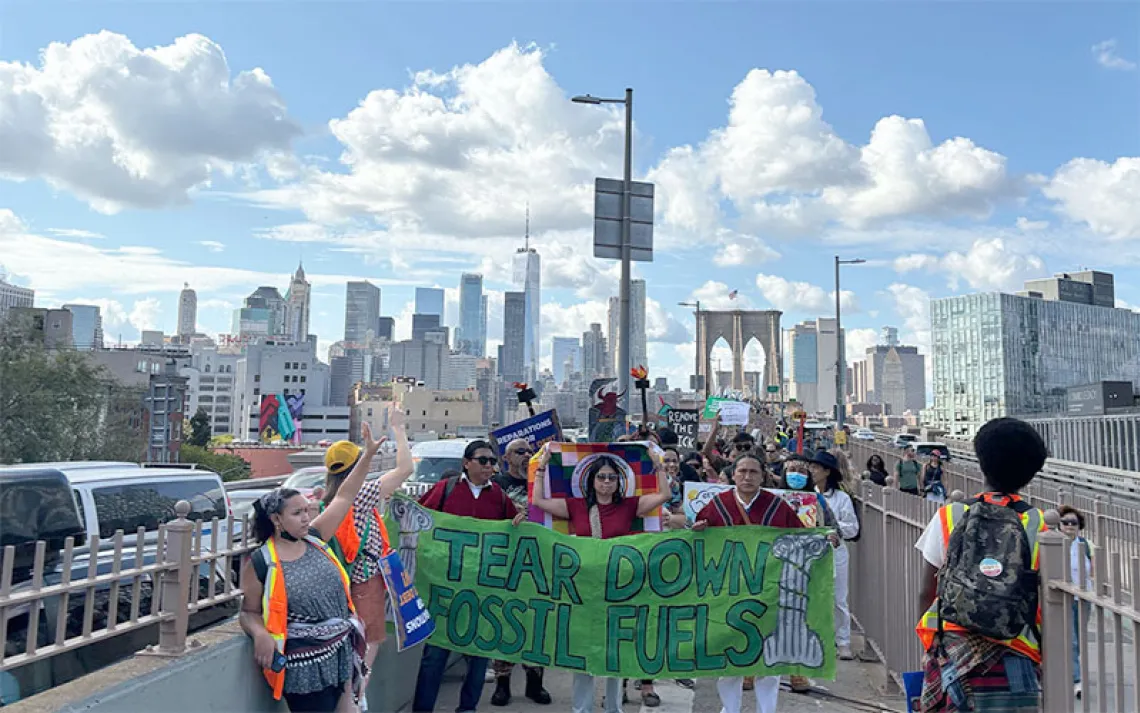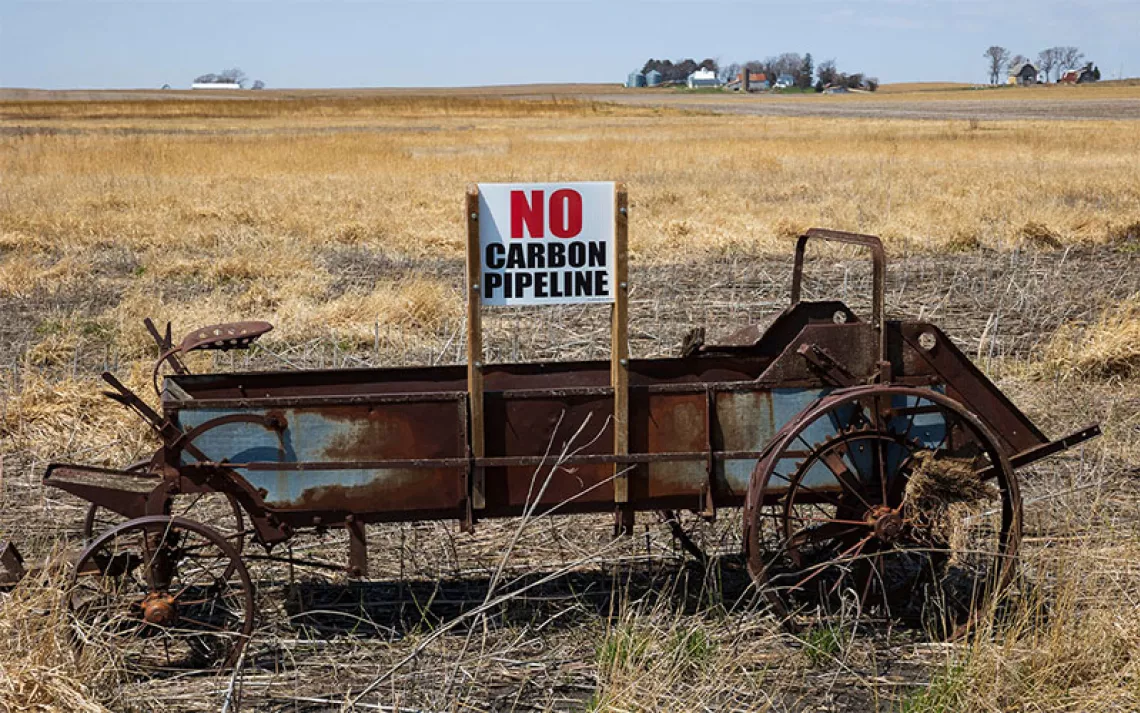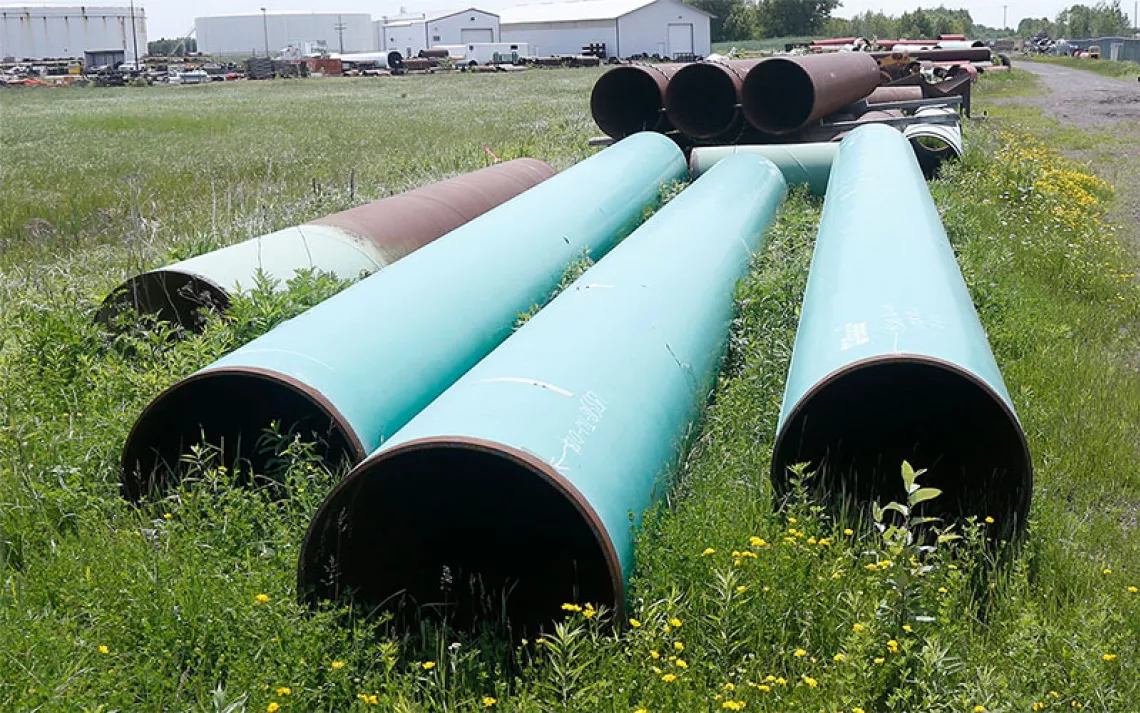Controversial Jordan Cove Gas Project Gains Federal Approval
While FERC has greenlighted the project, the battle isn’t over yet

Environmental protesters storm the capitol in Salem, Oregon. | Photo by Alex Milan Tracy/Sipa USA va AP Images
On Thursday, the Federal Energy Regulatory Commission, or FERC, voted 2-1 to approve the controversial Jordan Cove Energy Project, a hotly contested LNG (liquefied natural gas) terminal and 230-mile pipeline proposed for southwest Oregon. FERC authorized the project by delivering to developers an Order Granting Authority for the LNG facility and what’s called a “Certificate of Public Convenience and Necessity” for the pipeline—crucial permits that put the project one step closer to beginning construction.
Pembina, a Canadian fossil fuel infrastructure company, wants to build the Pacific Connector pipeline to carry fracked gas from Malin, Oregon, to a new LNG facility in Coos Bay. Much if not all of the fracked gas would come from the Montney formation in Alberta; once the gas is super-cooled in Coos Bay, it will be sent to overseas markets.
Though sorely disappointed by FERC’s decision, Jordan Cove opponents have been bracing for federal approval, given the regulatory climate for fossil fuel infrastructure projects under the Trump administration.
“FERC crossed a line today and ruled in favor of a private foreign corporation against its own country and the State of Oregon,” says Stacey McLaughlin, a landowner from Douglas County who faces eminent domain seizure of part of her property for pipeline construction. “All I can say is not on our land; not without a fight. We’ll do whatever it takes to protect our home.”
But the federal approval doesn’t mean the export terminal and pipeline are a done deal. The coalition of Native American nations, conservation groups, landowners, crabbers and fishermen, and climate change activists that has been fighting against the project for years remains cautiously hopeful that resistance by the state of Oregon may yet doom the fossil fuel build-out. The Jordan Cove project has yet to earn several key permits from Oregon agencies, including water quality certification from the state Department of Environmental Quality (DEQ); a removal-fill permit from the Oregon Department of State Lands (DSL); and a “consistency certification” from the Department of Conservation and Land Development (DLCD).
“The Jordan Cove LNG project has no viable path forward without the permits from the State of Oregon,” Allie Rosenbluth, a community organizer for Rogue Climate, told a local public radio station last month.
Over the last year, Oregon officials have signaled their reluctance to approve the LNG facility and pipeline.
FERC was scheduled to announce its decision on Jordan Cove on February 20. But the day before, the Oregon Department of Conservation and Land Development issued a letter explaining why it objected to certification for Jordan Cove. Required under the Coastal Zone Management Act, this basically affirms that the project as proposed does not conform with the state’s Coastal Management Program.
“DLCD has determined that the coastal adverse effects from the project will be significant and undermine the vision set forth by the [Oregon Coastal Management Plan] and its enforceable policies,” wrote DLCD director Jim Rue in his letter to Pembina. Rue also warned that FERC could not grant a license or permit for Jordan Cove without certification from his agency.
The next day, Bernard McNamee, one of the three FERC commissioners, said he needed more time to review the letter. Many hoped the delay was a good sign.
“I am still shocked that our government can take my property to facilitate a private Canadian company’s profits over upholding the private property rights of American citizens,” said impacted landowner Pam Ordway in a press release issued shortly after the February 20 FERC meeting. “I hope this factor is weighing heavily on FERC.”
A few days later, Pembina sent its own letter to FERC, stating that DLCD’s decision should not affect FERC’s, and that FERC should approve the project and simply require Pembina to acquire the necessary state permits before starting construction.
Now, FERC approval sets up a battle between state and federal authority.
The gas export terminal and associated pipeline have faced fierce opposition ever since the proposal was first introduced in 2004. Opponents cite impacts to water and wildlife habitat, damage to cultural resources, the use of eminent domain to acquire easements, and the risk of building an LNG facility in a tsunami and earthquake subduction zone. The pipeline route crosses hundreds of water bodies and would cut through old-growth forests and landslide-prone soils. Over 80 private property owners along the route have refused to sign easement agreements with the company, citing concerns over safety, wildfire, invasion of privacy, and noise.
More recently, opposition groups have ramped up their efforts, calling for lawmakers and the state of Oregon to reject Jordan Cove. Last November, about 75 activists staged a sit-in in Governor Kate Brown’s office in Salem. Twenty-one people were arrested.
All too often, states simply rubber-stamp these types of projects, says Andrew Hawley, an attorney for the Western Environmental Law Center who specializes in water quality issues. That has changed in recent years, as states like New York and New Jersey have used their authority to stop or delay pipeline projects they viewed as harmful. In Oregon, state officials have become increasingly clear that they expect a voice in determining the fate of Jordan Cove. After FERC released the draft environmental impact statement on Jordan Cove in March 2019, Oregon agencies collectively submitted nearly 250 pages of comments outlining their concerns.
“In a lot of places, Jordan Cove didn't provide enough information, and so the state wasn't able to make the determination,” Hawley says. “I give the state a lot of credit for standing up and saying, ‘Look, if you don't give us the information we need to do this analysis, then we're not going to do it.’”
In May 2019, the Oregon DEQ denied Jordan Cove water quality certification, which is required under Section 401 of the Clean Water Act. With its denial, DEQ asserted that Jordan Cove failed to show that its project will not harm the waters of the state. The agency made its decision without prejudice, so Jordan Cove could have submitted a new application. (As of this writing, the company still has not.)
The Oregon Department of State Lands was expected to weigh in on the removal-fill application on January 31 of this year, shortly before the FERC decision was expected. That permit is required before the company can begin the extensive dredging in the Coos Bay Estuary to accommodate the LNG terminal and tankers, or before it can drill under rivers, streams, and wetlands to make way for the 36-inch pipeline. Jordan Cove had appealed to the agency to extend the deadline. But on January 22, DSL director Vicki Walker sent Pembina a letter denying its request and outlining the many information requests and extensions already granted. Two days later, Jordan Cove pulled its application from DSL.
It might seem strange that Pembina would face the FERC decision without three major state permits in place, but Hawley suspects there’s a method to the company’s madness. In April 2019, President Trump ordered the EPA to amend Section 401 of the Clean Water Act to make it harder for states to block pipelines and other fossil fuel projects. In August 2019, the EPA proposed a new rule that promises to “streamline the federal licensing and permitting process.”
Changes to Section 401 would hamstring state agencies by limiting the period during which they can consider water quality certification to “a reasonable period of time” and by limiting the scope of what agencies can consider. Under the new rule, the Oregon DEQ couldn’t consider indirect effects on water quality—only direct discharges from a point source.
“[Pembina] knows as well as anybody that the Trump administration is going to need to finish those 401 rules before the spring,” Hawley says.
Susan Jane Brown, another attorney for the Western Environmental Law Center who has been working on Jordan Cove since 2004, says it’s possible Pembina would consider suing Oregon for “standing in their way.” If that happens, WELC would consider intervening on the state’s behalf.
So what happens now that FERC has offered its approval even though Oregon state agencies have not?
First, “everyone in the world” will petition for a rehearing, says Brown. This is basically a last-ditch effort to convince the FERC to reconsider its decision. If FERC denies the petitions, a tsunami of lawsuits will follow.
“It's kind of nice to be a lawyer in this situation because we have an embarrassment of riches,” says Brown. “Figuring out the best [litigation targets] is really going to be the hard part because there are so many good ones.”
Among her targets are the federal agencies that own land along the pipeline route.
The Bureau of Land Management wants to create a special designation for the pipeline right-of-way that would allow activities that remove spotted owl or marbled murrelet habitat or disrupt nesting. The US Forest Service has proposed removing about 15 forest plan requirements, one of which would exempt Pembina from having to “survey and manage” for rare species in the pipeline corridor.
WELC and other conservation groups might also sue FERC on the final environmental impact statement and/or challenge the US Fish and Wildlife Service or National Marine Fisheries Service on their biological opinions.
While Pembina must continue seeking its permits with the state of Oregon before starting construction, FERC approval means the company may begin the condemnation process on the private parcels it still needs for the pipeline. Landowners who have not signed easement agreements will likely challenge whether Pembina can use eminent domain for a project that the landowners argue does not meet the definitions of either “public interest” or “public need,” as defined in the Natural Gas Act.
“In our comments, we’ve shown that Canada is likely subsidizing its natural gas industry, which could ultimately impact US gas prices,” says Deb Evans, an impacted landowner who has submitted substantial comments to FERC and other agencies every step of the process. “We’re also saying that the use of eminent domain in this case not only helps Canada’s industry, but denies us our due process rights as guaranteed by the Constitution.”
Evans and a core group of landowners who call themselves the Landowner Advisory Committee are providing information and support to other landowners along the pipeline route. Several are being represented pro bono by the Niskanen Center, a libertarian-leaning think tank that specializes in civil liberties issues.
The court cases are likely to take years, and there is still a slim possibility that Pembina could pull up stakes altogether, especially if the market for LNG continues to tank.
One thing is for certain: The Jordan Cove saga ain’t over yet.
 The Magazine of The Sierra Club
The Magazine of The Sierra Club



